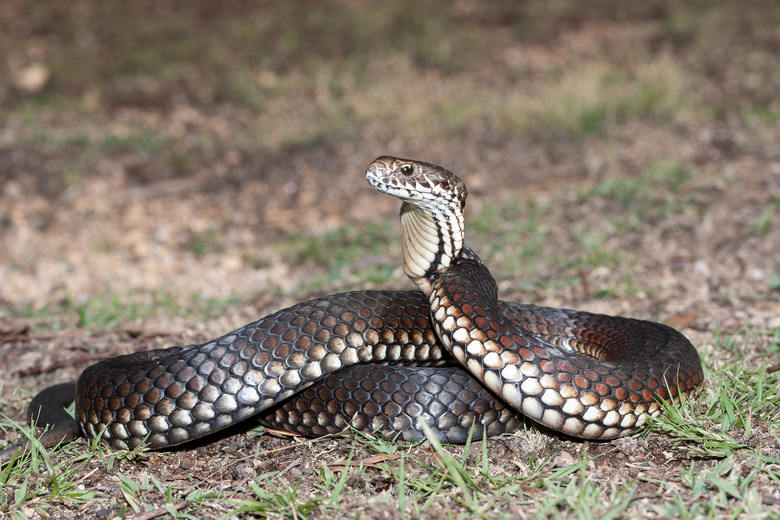Snakes Native To Tennessee
Tennessee has 32 native species of snakes, including multiple rattlesnakes in Tennessee, according to the website Snakes of Tennessee.
All of the venomous snakes in Tennessee are pit vipers, meaning they have heat-sensitive organs that allow them to detect prey in the dark. All of Tennessee's non-venomous species belong to the Colubrid family of snakes.
Harming or removing wild snakes is illegal in Tennessee.
Venomous Snakes
Venomous Snakes
Tennessee's venomous snake species include the Tennessee copperhead. The Tennessee copperhead has hourglass-shaped markings.
Other venomous snakes besides the Tennessee copperhead are rattlesnakes: the timber and western pygmy rattle snakes. Of these rattlesnakes in Tennessee, the Timber rattlesnake can be up to 5 feet long, while the Western Pygmy is rarely longer than 20 inches.
The aquatic western cottonmouth is also venomous and occurs west of the Tennessee River.
Aquatic Snakes
Aquatic Snakes
Five species of water snakes of the genus Nerodia, which give birth to live young, are found in Tennessee.
These include the the copper-bellied and yellow-bellied water snakes — subspecies of the plain-bellied water snake — as well as the Mississippi green and northern-diamondbacks water snakes. The broad-banded water snake occurs in the extreme western fringe of the state.
The Volunteer State also harbors the queen snake, an aquatic snake that has a yellow lateral stripe. It feeds mostly on crayfish.
King Snakes
King Snakes
Tennessee has several species of king snakes, such as the scarlet king snake, which is yellow, red and black. The scarlet king snake is a milk snake, named so because it was believed to suckle cows.
Red and eastern milk snakes also occur in Tennessee, as do yellow-bellied and common king snakes. King snakes will often eat other snakes.
Racers
Racers
If rattlesnakes in Tennessee are known for their rattle, racer snakes are known for their speed.
Tennessee is home to three subspecies of the North American racer: northern black, black-masked, and southern. Racers belong to the Coluber genus, which includes another speedy Tennessee snake, the eastern coach whip.
Ribbon and Garter Snakes
Ribbon and Garter Snakes
Three snakes of the Thamnophis genus — the orange-striped ribbon snake, common ribbon snake, and eastern garter snake — occur in Tennessee.
Ribbon snakes have three light-colored lateral lines that contrast against an otherwise dark body. Garter snakes also have distinct lateral lines, usually yellow in color, and alternating rows of black spots.
Brown Snakes
Brown Snakes
Two snakes of the Storeria genus — the midland brown snake and the northern red-bellied snake — are native to Tennessee. The former displays two parallel rows of dark spots.
Northern red-bellied snakes have three well-defined spots on the napes of their necks. Both species feed primarily on invertebrates, such as earthworms and slugs.
Earth Snakes
Earth Snakes
The rough and smooth earth snakes of the genus Virginia are the smallest snakes in Tennessee. They are usually between 7 and 10 inches long.
The rough variety occurs in southwestern corner of the state; the range of the smooth species encompasses most of Tennessee.
Other Snakes in Tennessee
Other Snakes in Tennessee
The aptly named eastern worm snake is found in Tennessee, where there is also a population of scarlet snakes, which resemble the scarlet king snake. The southeastern crowned snake, which ranges in color from tan to sorrel and has a white belly, is found throughout the state, as is the stout eastern hog-nosed snake.
The range of the arboreal rough green snake encompasses most of the Tennessee, which also harbors the western mud snake, the secretive ring-necked snake, and the northern pine snake. The gray rat snake and the red corn snake — known also as the red rat snake — are also among the state's slithery inhabitants.
Cite This Article
MLA
Alonso, Nathalie. "Snakes Native To Tennessee" sciencing.com, https://www.sciencing.com/snakes-native-tennessee-8468221/. 22 November 2019.
APA
Alonso, Nathalie. (2019, November 22). Snakes Native To Tennessee. sciencing.com. Retrieved from https://www.sciencing.com/snakes-native-tennessee-8468221/
Chicago
Alonso, Nathalie. Snakes Native To Tennessee last modified March 24, 2022. https://www.sciencing.com/snakes-native-tennessee-8468221/
